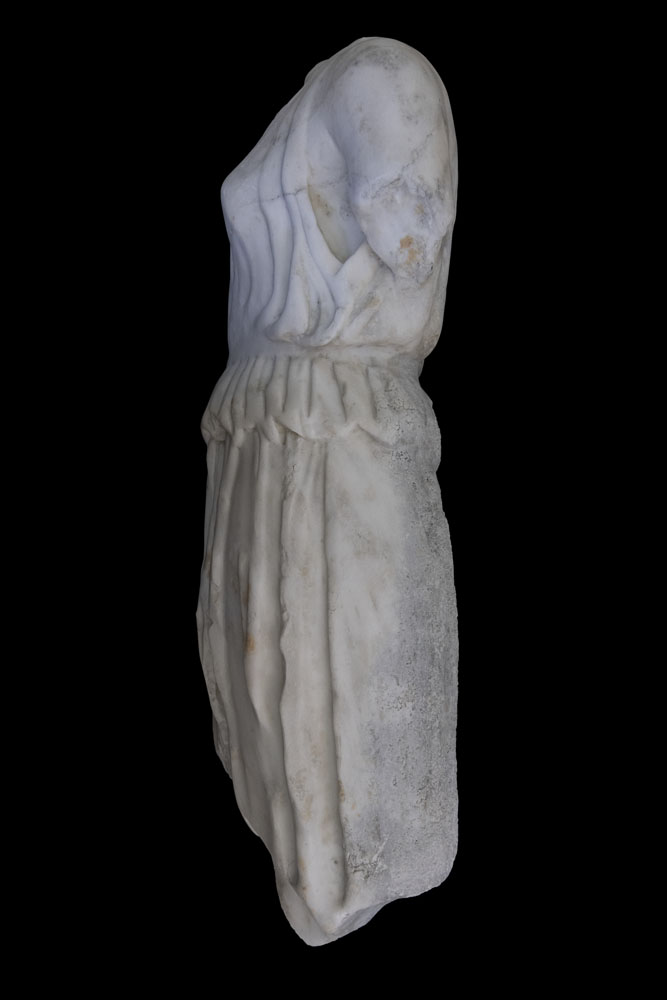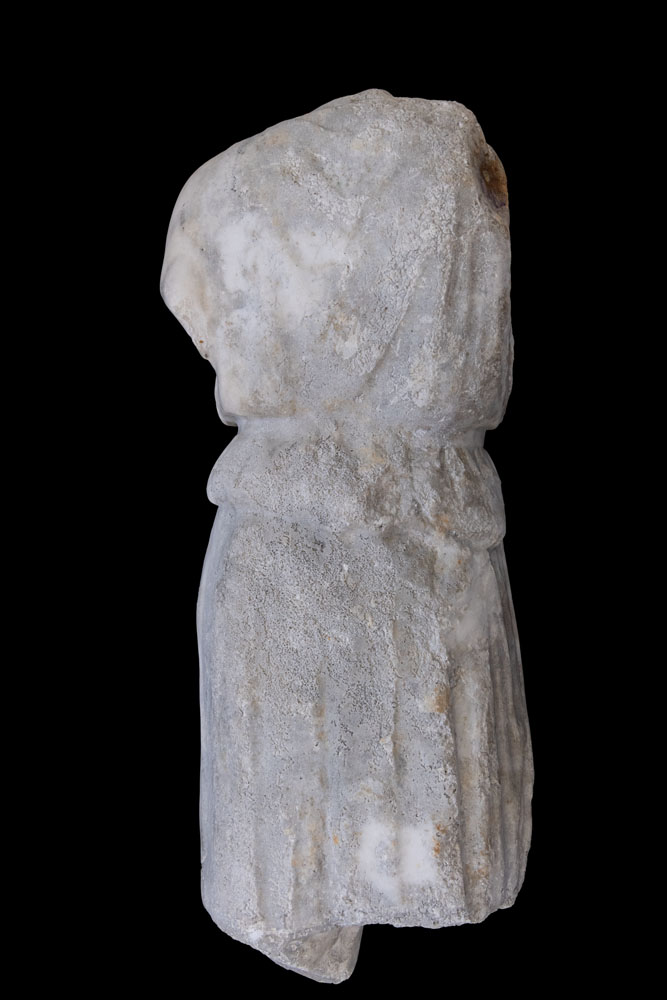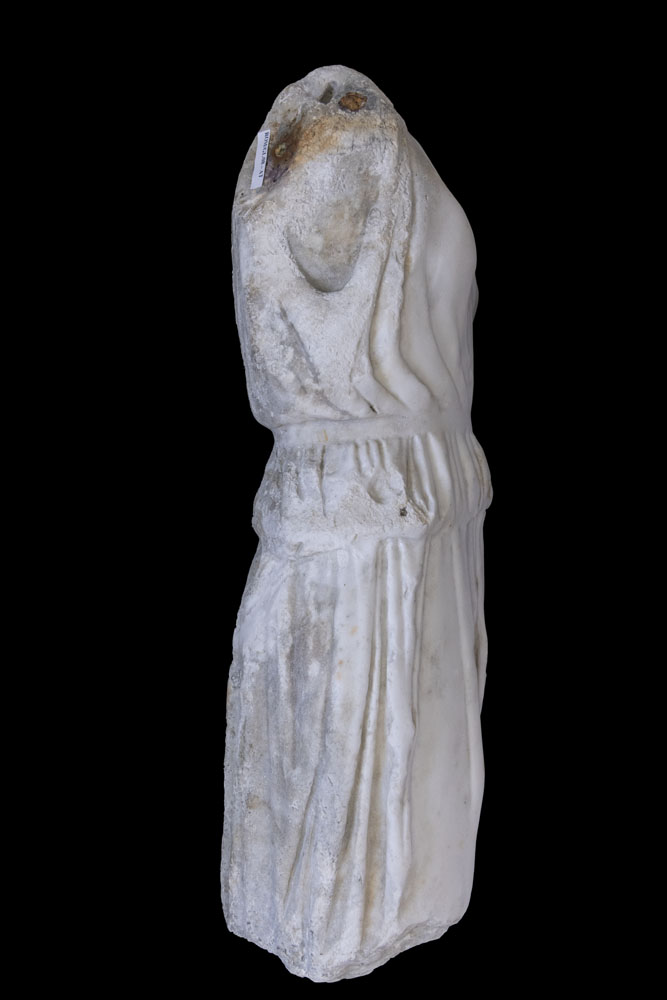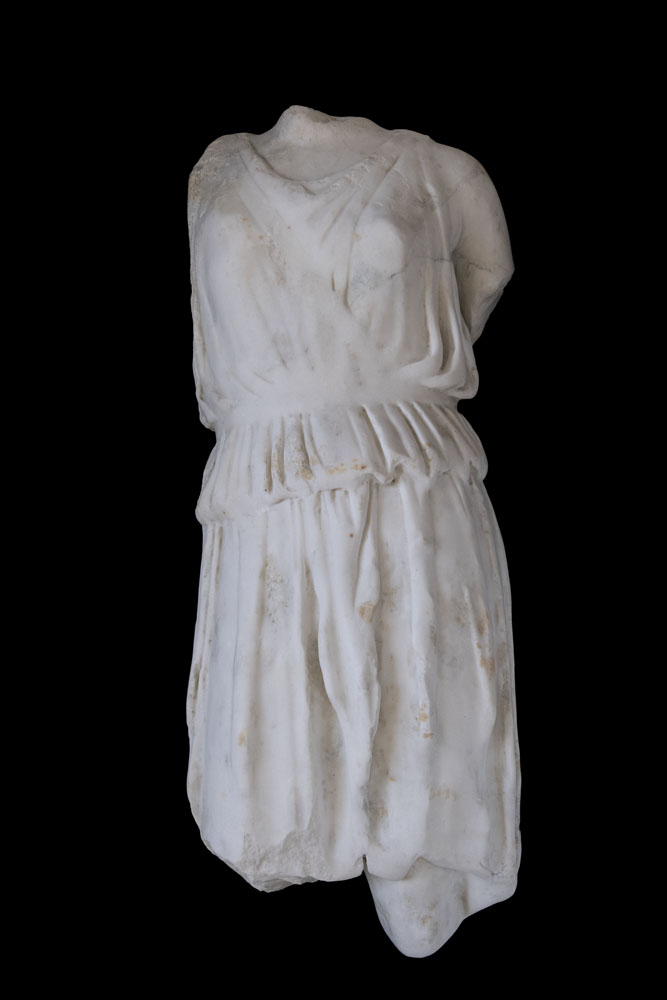Headless torso of Amazon
Category
Other StatuesAbout This Artefact
Title: Headless torso of Amazon
Content
I.D. no: 102539
Dimensions: Max. H. 95 cm; Max. W. 35 cm.
Material: Medium-grain white marble with prominent grey streaks
Provenance: From the sea mud below Corradino Hill in Grand Harbour, 1865[1]
Current location: National Museum of Archaeology
Condition: The statue seems to have been originally carved from a single block of marble, apart from the right arm and an object behind the right shoulder. Rather bad state of preservation. Missing head (broken off), whole right arm (originally attached to shoulder with a thick iron dowel), left forearm, and both legs, also broken off, the right one from mid-thigh, the left one below the knees. A smaller iron dowel in a shallow hollow surface behind the right shoulder at a lower level could have either also supported the right arm or, more probably, a separately attached pharetra of which no other trace is visible at the back. Large breakages on crests of drapery folds. Surface erosion throughout. Backside surface (including that of the broken neck) is covered with tiny holes (probably by boring sea creatures), but not uniformly. Some surfaces were not affected, suggesting that the torso had lain on its back on the surface of the seabed for many years and was only partially immersed in the mud. Rust stains are scattered on the surface below the belt.
Description:
The female figure rests on its left leg and bends the right one slightly forward. The right arm was probably raised high up, and the shoulders are inclined downwards accordingly to the figure’s left. It is clad in a short chiton (exomis) that seems to be knotted or clasped on the left shoulder and reaches down to the knees with a short overfold tightened at the waist by a belt (probably in another material over a plain carved horizontal strip). Both arms remain entirely unclothed but both breasts are covered. Another long, narrow and plain strip crosses the chest obliquely from the right shoulder to the left waist, probably intended to host the balteus (also in a different material) of the pharetra. The drapery timidly reveals the forms of the tensed left thigh and the bent right leg, where the folds are the least voluminous. In general the treatment of the drapery is still predominantly linear and superficial and tends to exhaust its function in a decorative key, expressed in multiple thinner folds separated by deep drilled channels below the belt. There is a major sense of vivacity in the thicker folds below the overfold.
Discussion:
Had the figure worn a nebris of animal hide over the chiton, it could have easily been identified with Artemis because it resembles similarly clad representations of the goddess.[2] But this absence and the rhythmic posture of the body, as well as the raised position of the right arm, recall much more closely one of the five different types of Amazons attributed to the three most prominent Greek sculptors of the second half of the fifth century BC (Phidias, Polykleitos, Kresilas) who according to an anecdote by Pliny (N.H. xxxiv, 53) took part, together with two other sculptors (Kydon and Phradmon), in a contest for the production of the best statue of an Amazon for the sanctuary of Artemis at Ephesos.[3]
In all three statues the right arm is raised above the head and the shoulders slope down to their left. But only in one type, the “Sosikles Amazon”,[4] is the figure resting on the left leg.[5] This is the type which has been by some attributed to Phidias and by some to Kresilas,[6] although the chiastic rhythm of the body agrees better with Polykleitos’ style.[7] The major difference between the Maltese torso and the Sosikles Amazon (as well as the other two Amazons) is that both breasts are clothed in the Maltese version. This, however, corresponds to another Amazon which has been tentatively attributed to the fifth contender in the contest, namely, Phradmon.[8] But in the latter the relation of the hips to the shoulders is reversed and it does not have an indication of a quiver belt across the chest. The pattern of both this and the waist belt cannot be traced in any of the other similar statues, except the “Torso of an Artemis” in the Vatican.[9] Even closer to our torso is the ‘Artemis/Diana’ from Caesarea Mauretaniae (modern Cherchell), assigned to the ‘Berlin-London’ group of replicas of an original Greek statue of the 4th century BC.[10] But the closest parallel in iconographic terms is certainly the ‘classicizing’ Roman torso of Artemis in the Ny Carlsberg Glyptotek of Copenhagen,[11] which shares the most important features with our statue, such as, the left leg bearing the weight, the shoulder line tilting down to the left, the covered breasts, the position of the belt and balteus, the length of the short chiton, the shape of the chiton overlap; so much so that one can say that the two torsos derive from the same original version of the subject. The only differences between the two are the much better quality of the carving and the state of preservation of the Glyptotek torso, as well as its trace of an attached animal on the side of the left knee.
This dual attribution (either Amazon or Artemis) brings up the question of the relevance of its findspot to the ancient landscape and topography of the area. What are the probabilities for the statue representing an Artemis or an Amazon? The circumstantial evidence, namely, the retrieval of several marble architectural fragments in the same area of the seashore might be said to militate in favour of an effigy of a divinity, in this case Artemis/Diana. However, as suggested by Pliny’s story of the competition, there was a tight connection between the figuration of amazons and Artemis after that episode. So although the Artemis option is more likely, the possibility of an Amazon is not to be excluded. Whether the find points to the existence of a temple dedicated to Artemis in the area is a completely different story altogether. A depth of fourteen feet for the seabed from which the statue was recovered cannot be explained away by rising sea levels since antiquity. While such a concentration of architectural and sculptural material could have resulted from a ruinous building on higher ground nearby, it is equally possible that the recorded objects were part of ballast disposed of by visiting boats from elsewhere in the Mediterranean.
As not a single parallel prototype has been found to fit exactly with our torso in all the essential iconographic features, it appears likely that we have here a copy of an eclectic original adaptation, inspired by several types of Amazon (or, possibly, Artemis) created towards the end of the Hellenistic age. The wide use of the running drill in multiple vertical folds on the drapery overlap below the belt might point to a second century date for the copy.
Bibliography: (previous publications of item):
Vassallo 1865: “busto di statua tratto dalla melma del porto nuovo”. Caruana 1882: 113: “statue of Diana, in marble, smaller than natural size; the head wanting; the arms and legs broken off, the latter from below the knees. … from a depth of 14 feet beneath the mud, in the basin of the new extension of the Harbour, at the foot of Casal Paola, in February 1865, and is preserved in the Library”. Ashby 1915: 29. Bonanno 1971: 206-209. Gambin 2004: 163-164. Gambin 2004-2005 [2008]: 51.
1 Vassallo 1865: 6: “dalla melma del porto nuovo”. Caruana 1882: 113. Ashby 1915: 29: “In the harbour extension works of 1865 … from a depth of 14 feet, two fragments of white marble columns, … and the torso of a statue of Artemis, smaller than life”. The find had also been reported in the local newspapers of the time (such as the Malta Times and United Services Gazette, 21 December 1865). T. Gambin (2004-2005 [2008]: 51) places this find, and others made in 1877, in the area of the Grand Harbour beneath Paola, referred to popularly as Ta’ Ras Ħanżir. A very fine and faithful pencil drawing of it was made and signed by G. Calleja. At the time the torso was thought to portray the goddess Artemis/Diana.
[2] E.g. Paribeni 1959 (Cirene): 70-71, nos 159-160, pl. 92; Huskinson 1975: 13, no 23, pl.8; Damaskos 2016.
[3] See L.I.M.C. vol. 1, nos 602, 603, 605, all sculpted with one bare breast. A number of scholars (including Ridgway 1974) discredit Pliny’s story to explain the existence of five different bronze statues in the Artemision of Ephesos.
[4] Sosikles being a Roman sculpture copyist.
[5] For the discussion of the different types and the literature thereon, see Weber 1976.
[6] von Bothmer 1957: 221-222; Weber 1976: 83-86.
[7] von Bothmer 1957: 222.
[8] Calza et al. 1977: 37-39, no 2, pls 3-4.
[9] Amelung I: 875, no 197, pl. 111.
[10] Landwehr 1993: 42-43, no 29: “Artemis”. It is more or less the same size and still has part of the pharetra at the back, which was sculpted from the same marble block, rather than attached with a dowel. The body rests on the right leg, rather than the left one, and it still carries a trace of an animal attached to it, which is not the case in the Marsa torso. Of greater significance is the knotted string below the breast instead of the belt at the waist.
[11] L.I.M.C. vol. 2,1: 643, no 223.




